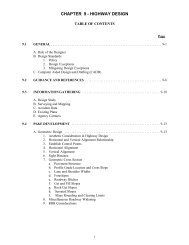Baltimore-Washington Parkway Widening Feasibility Study
Baltimore-Washington Parkway Widening Feasibility Study
Baltimore-Washington Parkway Widening Feasibility Study
- No tags were found...
You also want an ePaper? Increase the reach of your titles
YUMPU automatically turns print PDFs into web optimized ePapers that Google loves.
<strong>Baltimore</strong>-<strong>Washington</strong> <strong>Parkway</strong> <strong>Widening</strong> <strong>Feasibility</strong> <strong>Study</strong>Executive SummaryTraffic Volumes along the B-W <strong>Parkway</strong>Location 2010 2009 2008MD 295/I-695 89,963 89,422 89,421MD 295/MD 100 96,470 88,600 87,810B-W <strong>Parkway</strong>/MD 32 85,053 84,542 84,541B-W <strong>Parkway</strong>/I-95/I-495 110,542 109,881 109,880B-W <strong>Parkway</strong>/U.S. Route 50 104,492 103,871 103,870Impactson<strong>Parkway</strong>TrafficVolumesSource: Maryland State Highway AdministrationExisting and forecasted future traffic volumes estimates were compiled using the Metropolitan<strong>Washington</strong> Council of Governments’ (MWCOG) regional travel demand forecasting model. The modelincludes data that estimates future conditions, such as growth in population, jobs, and householdsanticipated from general economic development as well as the BRAC process. The model also includesconsideration of all transportation improvement projects planned for development by 2040, theproject’s future timeframe horizon. These projects are found in the currently adopted, fiscallyconstrained <strong>Baltimore</strong> and <strong>Washington</strong>, DC, regional long-range transportation plans. They include thecompletion of all sections of the InterCounty Connector highway between Prince George’s andMontgomery counties, the Purple Line light rail project in operation, and all projects identified tosupport BRAC development in the Fort Meade area. As shown in the table below, projections reveal agrowth rate of 38 percent in population and 47 percent in employment between 2005 and 2040.Projected Growth in the <strong>Baltimore</strong>-<strong>Washington</strong> Metropolitan Region2005 2040 GrowthPopulation 6,262,508 8,613,982 38%Employment 3,700,075 5,457,004 47%Sources: Metropolitan <strong>Washington</strong> Council of Governments and the <strong>Baltimore</strong> Metropolitan CouncilThe model output indicates that, from 2005 to 2040, the number of north-south trips in the studycorridor between <strong>Baltimore</strong>, Maryland, and <strong>Washington</strong>, DC, is projected to increase by about 34percent.7 November 2012
















